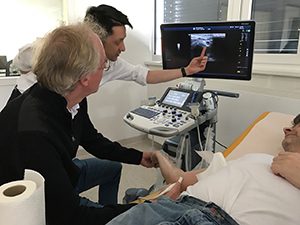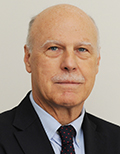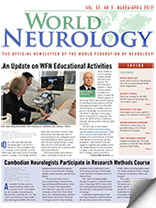Wolfgang Grisold
Ludwig Boltzmann Institute for Experimental and Clinical Traumatology and
Steven Lewis
World Federation of Neurology

Dr. Stefan Meng demonstrates nerve ultrasound at a peripheral nerve meeting in Vienna.
One of the most important and fascinating tasks of the WFN is education. This is an implicit task of a scientific society. Scientific societies have many other tasks, such as promoting science, exchange of knowledge, development, and cooperation. However, their most prudent and important task is to keep preparing for the coming generation and maintaining the present generation with education and knowledge to make them the best in their specialty. This ensures the optimal care for patients with neurological diseases.

Wolfgang Griswold
Neurology presence and workforce varies considerably around the world (Steck, Struhal et al. 2013) and also medical systems and educational systems. The WFN has had a number of educational programs throughout its history. Notably, the World Congress of Neurology (WCN) has served the purpose of fostering new development as well as educating neurologists in the field with the development of teaching courses to promote knowledge on a practical level. The World Congresses of Neurology has been doing this for a long time. As a whole, the WCN has been considered a primarily educational effort (Munsat, Aarli et al. 2009).
The WFN also provides Applied Research Groups, which serve to promote their subspecialty, for example motor neuron disease, neuromuscular diseases, neurosonology, and who, in addition to their scientific work, also engage in congresses and teaching courses. The Applied Research Groups are invited to engage on the structure and content of WFN teaching courses at each WCN.
WCN 2017
This year, the XVIII WCN will take place in Kyoto. It will be jointly hosted with the Japanese Society of Neurology. The congress will offer many educational components and disseminate the latest news and developments, as well as deliver many scientific sessions, teaching courses, and presentations and poster sessions, which all contribute to education in neurology. The WCN is a live event and is accredited by the EACCME for 8 CME hours a day, which is mutually recognized by the AMA and the Royal College of Physicians and Surgeons of Canada, thus being evaluated by high international standards.
Several attractive opportunities are implemented at WCN 2017. There will be congress bursaries, which in addition to the waiving of the congress fee will offer travel grants. This is aimed at young neurologists and is supported by the congress and, also in part, by the professional conference organizer Kenes. This year, travel grants for 80-90 persons are planned.
For the first time, the Munsat1 prize on education will be rewarded, named after Theodore Munsat (Medina 2014), who was very active in education and chaired the WFN education committee for several years. This prize will be awarded for the first time in Kyoto and will be an acknowledgement for persons involved in the promotion of education in neurology, and in particular educational activities within the WFN.
In addition to the scientific program, the WFN organizes teaching courses at several levels, hands-on courses, and educational sessions. The joint AAN-WFN Advocacy Palatucci workshop is a good example of a session teaching the skills of advocacy and leadership.
From the World Congress to Enduring Materials
Increasingly, the WFN also produces enduring materials, which are journal-published Congress abstracts, the Journal of Neurological Sciences (JNS) and eNS, the dissemination and organization of Continuum with the AAN for use in Continuum user groups, and, increasingly, the WFN website and social media.
Educationalists distinguish between live events and enduring materials. Enduring materials can be anything from printed, written material or media available as educational audio or video.
The WFN is in the good position to be able to use several publication materials, such as the website and social media, including Facebook, which among other activities also spread news and developments in timely ways and reach the groups of both young and middle-aged neurologists, and possibly also other health-related groups.
The JNS is the official journal of the WFN, and publishes material from studies, reviews, and cases, and has a large international participation. Two editor-selected CME articles appear on the website each month and can be downloaded free. The JNS is a continued success and is now edited by Prof. John England.
The journal eNS has been founded as an electronic open access journal, also serving as a platform for articles and cases, and has published several local features. It is meant to work in conjunction with the JNS. As it is an open access journal, fees for publication for open access articles are necessary, and this may be a hindrance in low-income areas; However, eNS is increasingly picking up momentum.
Continuum: Lifelong Learning in Neurology is a product of the AAN and published by Wolters Kluwer . Graciously over the years, the AAN has donated print copies of the journal to countries in need, on the condition that workgroups are constituted, that articles will be read and discussed, and these conferences will be reported back to the WFN. The logistics of the dissemination of this program is done by the WFN, which includes the mailing, sending, receiving, and accumulating the reports. This is an ongoing success story and the WFN and the AAN are happy to provide this service. For an example of a Continuum program, see the recent article on the Moroccan Continuum program.
Books: In the recent past, the WFN also produced a book series, Seminars in Neurology, which was aimed at countries with low education standards and limited resources of health care. Despite being a success, they became outdated and have been replaced by the other educational materials and endeavors discussed in this article.
Video conferences are presently launched on the WFN website and it is expected that video conferences on cases or diseases held between several departments will provide a useful academic support for training. Increasingly, video-type seminars will be used for educational purposes
The public: One of our main aims is the promotion of neurology, which is much wider that any training and education we do specifically for the specialty. Individual health groups, committed nongovernment organizations (NGOs), and patients need to be aware
of neurologic symptoms, diseases, and emergencies, and be encouraged to seek help for neurological conditions for themselves or others.
The aim of public education is to spread information on neurology, raise awareness and understanding, and improve the fate of patients with neurological diseases. All in all, this could be called advocacy work for neurology. Indeed, this is the greatest gap we need to fill. At present, a good example of educational aspects are the Days of the Brain, which are topic-focused and try to improve awareness with regard to specific neurological diseases.
World Brain Day: Education of the Public on a Larger Scale
A major initiative from the WFN is World Brain Day which had its origins at the WCN 2013 in Vienna, and will take place for the fourth time this year at the WCN in Kyoto, presented jointly with the World Stroke Organization.
The previous World Brain Day topics were epilepsy (with the International League Against Epilepsy [ILAE]) and dementia. The day commemorates the founding day of the WFN and is July 22.
Members are encouraged to celebrate this World Brain Day and receive educational matter, suggestions for press mailings, and printout material. Last year, a virtual press conference was added for the first time. Press mailings, articles, and local activities are considered as measures for success and were observed and counted.
Patient Day
The WFN has introduced the concept of a Patient Day at the World Congress of Neurology, which is a day and a session devoted to patients, careers, and health groups for the purpose of spreading news and interest of the Congress. This was successful in Vienna and in Santiago, and will need to be continued at further congresses. Common diseases such as stroke, epilepsy, and movement disorders are usually selected, and speakers from the Congress give talks in an understandable format.
Other Efforts
Public Relations and Press Conferences also serve to promote the content of neurology and serve the purpose of reaching out.
Junior Traveling Fellowships
Junior traveling fellowships (JTFs) provide support for individuals to attend meetings and congresses. The applications can be made worldwide, and applications from low- and middle-income countries are preferred. The participation in the meeting needs to be “active,” which means a presentation or a poster should be in the program. A final report is requested, which might be used for publication in World Neurology. In the last years, an average of 30 JTFs could be granted per year. Applications are announced on the WFN website.
WCN Congress Bursaries
The WFN also offers congress bursaries to attend the World Congresses. The bursaries are devoted to younger neurologists, with preference to applicants from low- and middle-income countries, and include a travel grant and free attendance to the Congress. The number grantees allowed depends on the Congress budget. Over the last several years, 55 bursaries were given in Marrakech, 120 in Vienna, and 30 in Santiago. This year, we are planning for 100 in Japan. In part, this is also supported by the professional conference organizer, Kenes.
IFMSA
The International Federation of Medical Students’ Associations is an international association of medical students. The WFN has cooperated with regard to students‘ medical curricula concerning neurology, and also provides free entrance for two students at the World Congresses.
Courses, Caravans and Regional Teaching Courses
The needs for education differ worldwide, and they are not limited to live events and enduring materials. Courses with nurses, paramedical professionals and other health groups can be necessary, as well as small standalone meetings. Some of these meetings have been funded by the WFN with grants.
A good example of a continuing joint activity by the EAN and WFN is to hold teaching/training courses in Subsaharan Africa each year. Last year the course took place in Maputo, Mozambique in November, and this year it will be in Ouagadougou, Burkina Faso. These EAN regional teaching courses usually attract 70-80 persons, have a lean teaching staff of 10-15 persons, and attract trainees from Africa to offer scientifically valuable and highly interactive courses. This education of trainees and young neurologists is important, as they will act as multipliers for the future development of neurology in Africa.
WFN Grants are Available Each Year
The idea of WFN grants was first introduced in 2011. Grants allocate a sum of money for a purpose and a project, which in many instances are projects related to neurologic education. The website shows details about the grant application. The WFN is also eager to share and participate in grants with other scientific societies such as the International League Against Epilepsy, the World Stroke Organization, and the Movement Disorder Society.
WFN grants are awarded once a year, and applications are scrutinized and selected by a grant committee.
Department Visits
In past years, the WFN, jointly with partner members, has developed a program of Department Visits, where young neurologists from low-income countries can go and stay for four to six weeks to study the procedures, techniques, and observe the neurologic work at a major neurological center. This program was introduced for African countries.
Turkey started this initiative with us, and it has now been followed by department visits in Austria, Germany, and Norway, and soon Italy. Names of fellows and reports can be seen in World Neurology articles.
Both the participants and the sponsors have been enthusiastic about this initiative, which not only introduces the participants to recent developments and up-to-date procedures, but also introduces new insights into other medical and social systems.
This year, North America is joining, and the Canadian Neurological Society is introducing a department program dedicated to countries in South America. This will expand this successful educational tools in the Americas.
WFN Teaching Centers
The development of WFN Teaching Centers was successfully introduced with the first WFN Teaching Center in Rabat Morocco in 2013. The idea is to train neurologists locally with high standards, and also acknowledge the high standard of the training center. The first Teaching Centers were successively established in Africa in Rabat, Cairo, and Dakar, and offer both “full training” and fellowship opportunities, which include electrophysiology and epileptology.
WFN Teaching Centers undergo a process of evaluation, a site visit, and re-evaluation after four years. The Teaching Centers also need to be embedded in a publicly accessible university, along with facilities and services that include internal medicine, radiology, neurosurgery, neuropathology, and rehabilitation.
At present, Rabat has had one fellow each year for the past three years, and will start to train a second fellow this year. Cairo is now starting with one fellow and Dakar will start with both a complete training position and one fellow on epileptology.
The WFN organizes the Teaching Centers with regard to administration, and also supports the WFN fellows. The applications for these training positions are announced via the WFN website and media. A committee, consisting of members of the WFN education committee, the local university, and the regional society, scrutinizes and selects the candidates.
The Applied Research Group on neuromuscular diseases held a very successful congress in Toronto in 2016. This Congress, ICNMD 2016 (icnmd2016.org/), also yielded a share of profit to the WFN, and the WFN has decided to use this money for additional funding of two successive training fellowships in neurophysiology, which will take place in Rabat, and possible cooperation with the international society of electrophysiology is planned.
In the Americas, Mexico has excellent neurological training programs, several of which were visited by the WFN in 2016 and received the status of WFN Teaching Centers. In 2017, attempts will be made by the WFN to sponsor one trainee from South America to train in a Mexican Teaching Center, and the preparations for this department visit are ongoing.
A further potential development for the WFN Teaching Centers could be regular visits from an international professor, who would stay a few days, give lectures, and make rounds in the department for a short time (e.g, a week). This would also help the WFN to identify the needs of the Teaching Centers more clearly.
The concept of the WFN Teaching Centers is expanding, to potentially include a Teaching Center in South Africa, and already for Rabat a re-evaluation process will be needed. The WFN is also aware that a Teaching Center should be available in Asia, which, while having very highly developed and scientifically active countries, still has several countries with significant needs with regard to neurology training. This will be an upcoming project.
Vision
Education is an ongoing process of innovation and renewal, and the prediction of the future is not easy.
There is a need for research into the most efficient and best educational methods. Apart from practical learning, training curricula and the apprenticeship type models prevail. In addition, much time now seems potentially spent (and perhaps wasted) on routine work, and some training curricula, too.
There is no doubt that time and experience count, but could we not improve in the efficiency of knowledge transfer? It will be an important effort and task for the WFN to stimulate research in the field of education.
With the rapidly expanding developments in neurology, training curricula and teaching concepts have an increasingly shorter half-life. In addition to the need for trainees and practicing neurologists to accumulate new knowledge at a fast pace, we must also invest in mechanisms to investigate and assess which skills and knowledge trainees need to acquire (e.g., the milestones that were developed by the Accreditation Council for graduate Medical Education [ACGME] and American Board of Medical Specialties [ABMS] in the U.S. [Lewis et al, 2014), and also mechanisms to replace “old knowledge” with new (unlearning).
There are, however more tangible projects currently in our sights, such as the expansion of the WFN Teaching Centers, development of education on electronic WFN platforms, and the development of a global curriculum for training of neurology, aiming for suggestions with regard to the teaching and training methods, taking into consideration differences in local needs and resources.
Most important is the vision to increase efforts on public education and involvement of patients and patient groups. Awareness, prevention, understanding, and care for patients with neurological diseases need to be one of our major tasks.
References
- Theodore L. Munsat (1930-2013). US neurologist, long term chair of the WFN education committee and also founding director of “Continuum.” See: http://worldneurologyonline.com/article/theodore-l-munsat-1930-2013-an-outstanding-legacy-with-the-wfn/
- JA, A. “The History of the World Federation of Neurology: The First 50 Years von Johan A. Aarli.” OUP Book: 2014
- Medina, M. T. (2014). “In memoriam of Professor Theodore L. Munsat (1930-2013): his outstanding legacy with the WFN.” J Neurol Sci 339(1-2): 1-2.
- Munsat, T., J. Aarli, M. Medina, G. Birbeck and A. Weiss (2009). “International Issues: educational programs of the World Federation of Neurology.” Neurology 72(10): e46-49.
- Steck, A., W. Struhal, S. M. Sergay, W. Grisold and N. Education Committee of the World Federation of Neurology (2013). “The global perspective on neurology training: the World Federation of Neurology survey.” J Neurol Sci 334(1-2): 30-47.
- Lewis SL, Józefowicz RF, Kilgore S, Dhand A, Edgar L. Introducing the neurology milestones. J Grad Med Educ. 2014; 6(1 Suppl 1):102-4.
